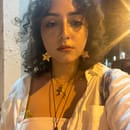Over the past month, we have seen an eruption of protests calling for a ceasefire and an end to the siege on Gaza, not only globally, but in our own backyard, with protests, vigils, and walkouts organized by VCU students and Richmond activists. In every one of these demonstrations, you will see nearly everyone sporting a checkered, embroidered black and white scarf, known as the Keffiyeh.
If you, like many people right now, were previously unfamiliar with the Palestinian plight for liberation, and have just recently been introduced to the movement after October’s events, you probably have lots of questions and some of those questions probably revolve around the Keffiyeh, its significance, and how it came to be the symbol of resistance it is today.
History Of The Keffiyeh
The Keffiyeh finds its roots in 3100 BCE Mesopotamia—or modern-day Iraq—where an early version was worn by Sumerian priests to distinguish honor and social status within their society. As is the natural evolution of fashion symbolism, the Keffiyeh, once worn as a symbol of a high social ranking, made its way throughout the Middle East where it was eventually adopted by traveling bedouins and Palestinian farmers as technical wear, providing them with protection from the sun and the occasional sand storm.
The practical usage of the Keffiyeh is not where this evolution ends, as the Keffiyeh once again evolved from its practical purposes into a mask wrapped around the faces of revolutionaries during the 1930s Arab revolt, to protect their identity. When the British mandate responded by attempting to ban the Keffiyeh, the attachment to it only grew stronger, solidifying it as a symbol of Palestinian resistance.
The Keffiyeh’s political symbolism was only further cemented in the 1960s, when Yasser Arafat, Palestine’s former President, deliberately fashioned one in every public appearance.
The subtle act of resistance that is wearing the Keffiyeh is no longer confined to Palestine. For years, this fashion symbol has been internationally recognized as a symbol of resistance and solidarity with the Palestinian people and all those who are oppressed.
What Do Keffiyehs Look Like?
Modern-day Palestinian Keffiyehs are white square scarves, typically made of a cotton-wool blend, that feature a black and white checkered pattern. This pattern, while seemingly random, consists of a combination of historical and cultural symbolism.
The Keffiyeh features a fishnet pattern, a representation of Palestinian’s deep connection to the sea and their fishing traditions; a pattern depicting the trade route, which represents the rich cultural exchange between Palestine and neighboring regions, such as the Middle East, North Africa, and Europe, via the historic trade route; and a pattern representing the olive trees of Palestine, a closely held physical manifestation of resilience and prevailing connectedness to the land.
A combination of these symbolic patterns constitutes the cross-stitching on the Palestinian Keffiyeh. This piece of textile, contextually and symbolically, holds the power of communicating resistance and solidarity. Globally, it has become a powerful symbol connecting all oppressed peoples, and their allies, in solidarity not only with Palestinians but anyone who shares their struggle.
While Keffiyehs come in many different colors, the black and white rendition is most closely associated with Palestine; a result of Arafat’s frequent wear of the black and white version, which created an association between the colors and the resistance movement. Another popular version of the Keffiyeh is the red and white pattern, which is more closely associated with Jordan and the Arabian Gulf.
Who Makes Keffiyehs Today, and Where Can I Get One?
The occupation of Palestine has resulted in the demolition of its peoples’ countless valuable cultural practices and traditions over the years. Palestine’s treasured Olive trees, passed down through generations, now forcefully uprooted and destroyed, serve as a reminder of the loss of culture that comes with colonial projects like the Israeli occupation.
Another painful reminder of this is the Hirbawi factory, Palestine’s last standing Keffiyeh factory. The factory was founded by the late Yasser Hirbawi in 1961, when Keffiyeh factories were plentiful throughout the country, and is now kept alive by his sons.
With the current conversations around boycotting and BDS, it is important to remember that financially supporting Palestinian-owned businesses, especially those based in Palestine, is an equally important contribution to the resistance movement.


